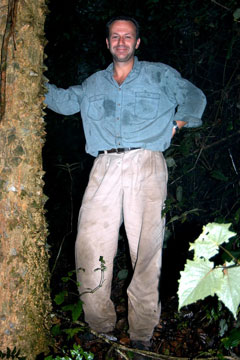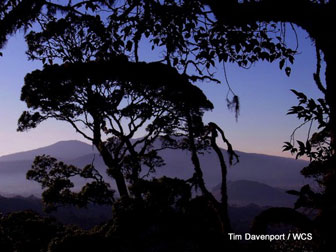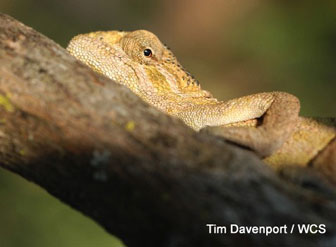Conserving wildlife in Tanzania, Africa’s most biodiverse country
An interview with Tim Davenport:
Conserving wildlife in Tanzania, Africa’s most biodiverse country
mongabay.com
November 8, 2006
With ecosystems ranging from Lake Tanganyika to Mt. Kilimanjaro, Tanzania is the most biodiverse country in Africa. Though Tanzania is world famous for its safari animals, the country is also home to two major biodiversity hotspots: the Eastern Arc Mountains and the Albertine Rift surrounding Lake Tanganyika. Tanzania has set aside nearly a quarter of its land mass in a network of protected areas and more than one-sixth of the country’s income is derived from tourism, much of which comes from nature-oriented travel.
|
Dr Tim Davenport in Tanzania’s highland forest near Mt. Rungwe. |
Despite these conservation achievements, Tanzania’s wildlands and biodiversity are not safe. Fueled by surging population growth and poverty, subsistence agriculture, fuelwood collection, and timber extraction have fragmented and degraded extensive areas that are nominally protected. Hunting and unsustainable use of forest products have further imperiled ecosystems and species. In the near future, climate change looms as a major threat not only to Mt. Kilimanjaro’s glaciers, which are expected to disappear within ten years, but also to Tanzania’s many endemic plants and animals found in its montane forests.
Working to better understand these threats and safeguard Tanzania’s biodiversity for future generations is Tim Davenport, Country Director for the Wildlife Conservation Society (WCS) in Tanzania. Davenport, who co-discovered a species of monkey in the Southern Highlands region of Tanzania in 2003, has been working in Tanzania with WCS since 1999.
In November 2006, Davenport kindly answered some questions from mongabay.com. He says that though “humans are not by nature a sustainable animal”, conservation success in Tanzania is possible through education, better understanding of local economics, and sustainable development. To future conservationists, Davenport offers this key advice: “don’t give up.”
An interview with Tim Davenport
Mongabay: How did you get involved in conservation and why did you choose East Africa for your work?
|
Dr Tim Davenport after a hike in the Tanzanian forest. |
Davenport: I’ve been interested in the natural world for as long as I can remember. In fact some of my earliest memories are of looking at the pictures in National Geographic, especially those late 60’s early 70’s editions about sharks and chimpanzees. My interest in biology led to a BSc in Zoology at the University of Leeds in England, although I never thought I would end up in conservation. All the ecologists at University seemed very serious and intellectual. I was neither. But when I was given the opportunity to stay on and work for a PhD, I grabbed it. After that I worked briefly as a Science Editor, and then applied for a position in the early 1990’s with the Uganda Forest Department, assessing the biodiversity of the natural forest estate. It was a fantastic and unique experience and I have been in Africa ever since.
I never actively chose East Africa. I stayed on with the Uganda Forest Department and then worked in Bwindi Impenetrable and Mgahinga Gorilla National Parks and also Makerere University. I ended up living in Uganda for five years. That was followed by a completely different experience working in the forests of southwest Cameroon with the Worldwide Fund for Nature. I eventually moved to Tanzania with the Wildlife Conservation Society (WCS) in 1999.
Mongabay: On paper Tanzania has set aside more than a quarter of the country in protected areas — an outstanding conservation achievement. How does this translate in practice? Are parks well-respected or do they suffer from poaching, deforestation, and other issues? Do local people take well to conversation efforts or are there conflicts?
 Bustani ya Mungu – God’s garden. Satyrium and Habenaria orchids on Kitulo Plateau. Photo: Tim Davenport / WCS |
Davenport: Parks, reserves and protected areas all over the world face problems and suffer from illegal activities. But Tanzania faces two extra hurdles. One is the poverty that dominates everyone’s lives and every decision. The other is the huge responsibility that goes with having to manage the most biodiverse country in Africa.
It’s true that a large percentage of the country is nominally set aside, but in reality outside the national parks, resources to manage these areas are often very limited. That is a big challenge. Furthermore, the majority of protected areas were gazetted in colonial times and were based solely on the management of big game for hunting. This was well before the days of biodiversity conservation, ecosystem services protection and representative PA systems. That said, progress is being made, not least with the country’s newest national park, Kitulo, which was designated primarily to protect its unique wild flowers.
Mongabay: Last year you co-discovered a monkey species that so unique that it was classified as its own genus — the first such categorization for a monkey since 1923. What is the outlook for this species and other wildlife in Tanzania? What are the greatest threats to biodiversity and wild lands?
Davenport: As a conservationist I am an optimist by nature, although sometimes it is difficult to stay that way. The Kipunji is seriously threatened and will probably be designated as ‘Critically Endangered’. We are currently just finishing a complete census – one in which we have tried to locate every group in existence, and count all the individuals within each group – and we will be making this information available soon. As you can appreciate, this has been time consuming, and with the steep montane forest terrain it’s also been quite tough. However, it was important we could do this as quickly as possible, so that we can try and put in place the most effective conservation strategy. Spending so long in the forest has also enabled us to learn a lot about the ecology and behaviors of the Kipunji too, and that has been both useful and good fun.
|
The Kipunji (Rungwecebus kipunji). Photo by Tim Davenport. |
On the downside though, Mt Rungwe – where the biggest numbers of Kipunji live – is in a very bad condition having had no effective management for decades. Illegal logging, charcoal extraction and hunting are all common and the forest is badly degraded. Many of the larger mammals, such as the extremely rare Abbott’s duiker, are under considerable threat from snares. To make things worse, as a result of the poor forest, many species (including Kipunji) are forced to come out of the forest more and more to raid crops. Consequently, they are often killed in traps set by farmers who are just trying to protect their livelihoods.
So we are working with government and local communities to see how best we can manage Mt Rungwe for the benefit of all concerned. We are also using the Kipunji and Abbott’s duiker as ‘flagship species’ in our education work in the villages and schools around the mountain.
Mongabay: You’ve worked in the montane forests of Tanzania — areas that seem like they could be vulnerable to climate change. Do you expect global warming to impact these forests? How much of a local threat is climate change?
|
Mt. Rungwe. Photo by Tim Davenport. |
Davenport: It’s difficult to say. Whilst I have no doubts about the negative impact mankind is having on our climate, predicting future impacts is not easy. In part because there are so many variables to consider. If forests are shrinking (and we know they are), how much is it to do with unmanaged extraction, how much is due to fire, and how much a change in climate? Similarly, we have noticed streams and rivers drying up. Is this a direct result of forest clearance, is it due to water being diverted for irrigation, or is the story more complex? Whilst we are trying to sort these questions out, we obviously have a responsibility to get all the facts right first.
Mongabay: What’s the best way to protect Tanzania’s wildlife? How can conservation efforts be improved? Does eco-tourism have a role or can tourists be disruptive to habitats and local culture?
 The Livingstone escarpment within Kitulo National Park viewed from the summit of Mt Rungwe. Photo: Noah Mpunga / WCS  The Poroto Three-horned Chameleon (Chamaeleo fuelleborni) is one of the rarest chameleons on the continent, globally restricted to just four sites in Tanzania’s Southern Highlands. Reaching a length of 22 cm, the males of this arboreal species are highly territorial, using their horns to fight for females. They give birth to as many as 15 live young (Photo (c) Tim Davenport / WCS) |
Davenport: Conservation is an extremely complicated business. In order to be truly successful, all the pieces of the puzzle must be in place. The real conservation problem must be fully understood, all motives must be known, effective and appropriate incentives need to be devised and monitored, and there needs to be the political will to support any changes. Humans are not by nature a sustainable animal. Learning to become one against a background of rising population is extremely difficult. In many ways the science of conservation is economics, and the art is politics. The biology is often just the more glamorous part that underpins it.
There may not be a single best way to protect Tanzania’s wildlife, but the better current approaches are usually broad based. I’ll always think, for example, that education is vital.
For conservation practioners the stakes are high. Neither governments, local communities or donors tend to tolerate failure and yet in a business that is so complex, we all need the freedom to try new methods and learn from our mistakes. Sadly, there is rarely that luxury.
Eco-tourism does have an important role, although increasingly these days the phrase has become less meaningful. All too often the word has been hijacked by less scrupulous business people in a bid to attract customers. That said, tourism contributes 17% of Tanzania’s GDP, so is clearly of massive importance to the country. It is important to remember however, that tourism is not in itself the panacea. Many of the more remote areas (such as the Southern Highlands) are unlikely ever to raise enough from tourism to sustain conservation, and so they will have to rely on other means or funds from other sources to support conservation efforts.
Mongabay: How can people here in the United States help with conservation efforts in Tanzania?
|
Photo by Tim Davenport. |
Davenport: Directly, they can support any of the various non-profit organizations that work in Tanzania, or even offer to assist as a volunteer. Links between towns or schools are always good ways of helping out. You would be amazed at how much can be done with a little imagination. We have a Kipunji Fund set up specifically to help us protect the Kipunji and its habitat, and many projects have similar campaigns. I would also strongly encourage people to visit Tanzania. It is an extraordinarily beautiful and diverse country with a sincerely welcoming people. It has Africa’s highest mountain and deepest lake. It has the Serengeti and the Indian Ocean. An important thing to remember is to try and spend as much money locally and in-country as possible.
Indirectly, I think it is extremely important that everyone helps keep the environment high on the political agenda. Future generations will not thank us for opting for quick profits now for a few, over a more sustainable and healthier future for the majority.
Mongabay: Finally, do you have any advice for students wanting to pursue a career in conservation?
|
Photo by Tim Davenport. |
Davenport: Firstly, I’d say that whilst biology is the traditional route, there are many other much needed – and often underutilized – skills too, including economics, the law, sociology, IT, anthropology, politics, education, etc. The key skills needed by a conservationist however, are a broad general knowledge and good people skills. So the more people can travel, read and listen, to as many different places, on as many different subjects and to as many different opinions as possible, the better.
And finally don’t give up. If you do, you were probably not right for conservation in the first place.
Related links
About Tim Davenport
Tim Davenport was born in Manchester, UK and has lived and worked in three African countries since finishing his Zoology PhD. In Uganda, he worked for the Forest Department, Makerere University and Uganda National Parks, and in Cameroon, he ran projects for the Worldwide Fund for Nature. Tim moved to Tanzania with WCS in 1999, and there he set up the Southern Highlands Conservation Program (SHCP) in southwest Tanzania, and the Southern Rift Program in Tanzania, Malawi and Mozambique. Both programs carry out research, community conservation and protected area management in key threatened habitats. Tim has worked in over 80 African forests and reserves, and been involved in the designation of new national parks on both sides of the continent. He has published on subjects ranging from national conservation priorities to invertebrate ecology, and from the orchid trade to chimpanzee distributions. He led the team which first discovered the Kipunji (Rungwecebus kipunji) on Mt Rungwe, and was lead author in a May 2006 article in the journal Science that described the Kipunji as Africa’s first new genus of monkey for 83 years. His photographs have also been widely published. In September 2006, Tim was appointed as the WCS Country Director in Tanzania. In addition to the SHCP, WCS has conservation projects in the Tarangire-Simanjiro Ecosystem in northern Tanzania, the Saba Landscape of Rungwa-Ruaha, the coastal forests of Zanzibar, as well as research projects in the Serengeti, the southern Tanganyika lakeshore forests and the Eastern Arc Mountains.




















